Lin & Lin Gallery’s latest exhibition, Intermedium (媒介), features artists from around the world whose work combines multiple artistic mediums. Lu Hsien-ming’s (陸先銘) paintings on stainless steel critique the effects of the manufacturing industry on Taiwan’s environment. Lu documents the rapid change in Taipei’s cityscape from bamboo structures of earlier years to the tall, dreary buildings and overhead passes that we see today. Also in the lineup is Spanish artist Jose Maria Cano’s paraffin wax portraits of people pulled from pages of the Wall Street Journal, including Barack Obama and Alan Greenspan.
■ Lin & Lin Gallery (大未來林舍畫廊), 16, Dongfeng St, Taipei City (台北市東豐街16號), tel: (02) 2700-6866. Open Tuesdays to Sundays from 11am to 7pm
■ Opens tomorrow. Until March 27
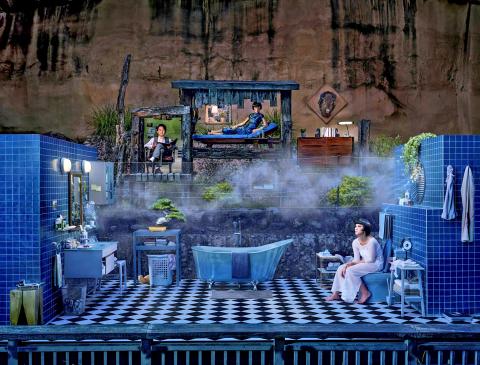
Photo courtesy of Chini Gallery
The Hsinchu-born Tseng Lin-yuan (曾麟媛) may seem too young to be reflecting on her childhood and painting whimsical memories of it (she’s in her mid-20s), but this skilled artist manages to do so in a way that is detached and introspective. Tseng achieves this through colors, movement and painting indistinct objects rather than drawing people. Her latest exhibition, One of Those Days (拾掇那些日子), which opens at Taipei’s Aki Gallery next week, is named after Shi Shu-ching’s (施叔青) novel of the same name. While the tone in Shi’s novel is forlorn, Tseng uses bright colors to depict balloons, merry go-rounds and paper airplanes. On the surface, her work seems happy and nostalgic, but there’s also a certain sadness to it. In fact, the blurred images appear to be a deliberate attempt to conceal one’s feelings or emotions.
■ Aki Gallery (也趣藝廊), 141 Minzu W Rd, Taipei City (台北市民族西路141號), tel: (02) 2599-1171. Open Tuesdays to Sundays from noon to 6:30pm
■ Opens tomorrow. Until March 27
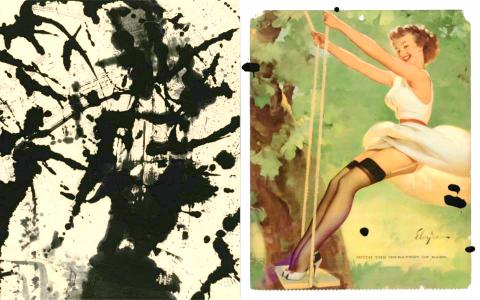
Photo courtesy of Galleria
Photo-journalist Chou Ching-hui’s (周慶輝) decades-long career has come a long way from his early black-and-white portraits of rural schoolchildren and factory workers to bizarre, dystopian images of inanimate-looking people arranged in zoo-like exhibits for his latest series of photographs, Animal Farm. A selection of Chou’s work over the last two decades are currently on display at Taipei’s Chini Gallery, in the exhibition In the Name of Documenting (以人之名). The title is fitting as Chou takes an anthropological approach to photography. It grows stronger in his later work, and especially in the Animal Farm series where Chou spent five years studying the arrangement of different zoos throughout Taiwan and photographed people in such a way that it seems like they are being examined under a microscope — much in the same way that we gawk at animals at the zoo.
■ Chini Gallery (采泥藝術), 48, Lane 128 Jingye 1st Rd, Taipei City (台北市敬業一路128巷48號), tel: (02) 7729-5809. Open Tuesdays to Sundays from 10:30am to 7pm
■ Until April 3
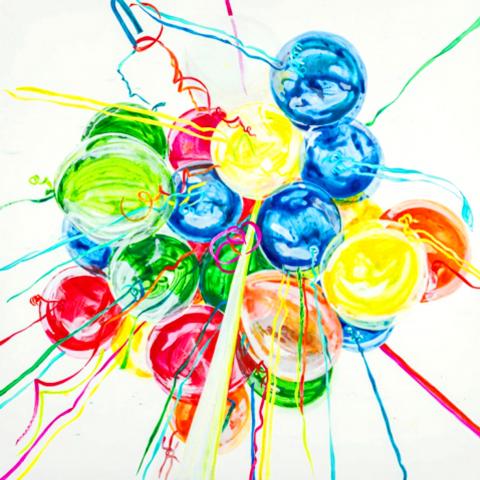
Photo courtesy of Aki Gallery
It’s clear that Keng Hao-kang (耿?剛) knows how to enjoy the finer things in life. He studied painting and installation in Italy and worked at Hugo Boss for several years upon returning home to Taiwan. His eye for fashion certainly plays out in his latest solo exhibition, Pin-up·March (三月。小甜心), which opens at Taipei’s Galleria H tomorrow. The exhibition’s content is self-explanatory — images of pin-up girls in calendars for the month of March. Though what’s interesting is the way that Keng uses Chinese ink on rice paper and morphs them with images of American pin-up girls from the 1950s. The result is as humorous as it is awkward. It also shows that the fascination with pin-up girls transcends cultures and time.
■ Galleria H (恆畫廊), 12-1, Ln 58, Xinsheng S Rd, Taipei City (台北市新生南路一段58巷12-1號), tel: (02) 3322-2553. Open Tuesdays to Sundays from 1pm to 7pm
■ Opens tomorrow. Until April 3
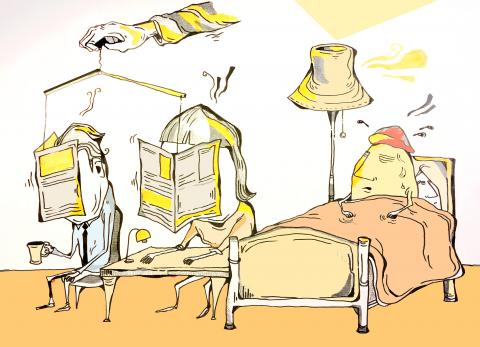
Photo courtesy of Liang Gallery
You might recognize Candy Bird’s colorful graffiti murals of big-headed creatures that cover entire walls of dilapidated buildings around Taipei. The street artist, who got his start by painting on walls along his delivery route while working as a delivery man, has come a long way — he has a solo exhibition opening at Liang Gallery tomorrow. Entitled Bedtime Stories (床邊故事), the artworks displayed revolve around, well, bedtime stories. Don’t expect warm, fuzzy imagery though, as Candy Bird’s big-headed creatures — this time, it is a rather kooky-looking mother-son duo — are the protagonists. Candy Bird likes to teach his viewers that it is okay to conform to norms, and he does so in a way that’s playful and silly.
Sticking to the theme of sleep (or in this case, the lack of it), Do You Dream of Electric Sheep? (你夢見電子羊了嗎?) by Chen I-chun (陳依純) also opens at Liang Gallery tomorrow. Chen takes on a more pessimistic view. In the past, Chen’s paintings, sculptures and installations have explored the dangerous conditions of Taiwan’s factory workers and this exhibition addresses similar subjects. The “electric sheep” in this case are blue collar workers who perform the same redundant jobs — so much so that their thinking and movements have become mechanized. Her artwork depicting machinery and robot-like people possesses both a lulling quality as well as a sense of restlessness.
■ Liang Gallery (尊彩藝術中心), 366, Ruiguang Rd, Taipei City (台北市瑞光路366號), (02) 2797-1100, open Tuesdays to Sundays from 11am to 6pm
■ Both exhibitions open tomorrow and run until April 3
Architecture buffs will be happy to know that the famed London-based Heatherwick Studio, founded by Thomas Heatherwick in 1994 and known for their sleek, futuristic designs, will be featuring a couple of their sketches and models at the Taipei Fine Arts Museum (TFAM) starting tomorrow. The touring exhibition, entitled New British Inventors: Inside Heatherwick Studio (新世代英倫創造:走進海澤維克工作室), will provide an up-close view of the architectural process, from initial concept to final product. Heatherwick Studio is known for their award-winning UK Pavilion at the 2010 Shanghai Expo, the cauldron for the London 2012 Olympic Games and, most recently, their spirally, eight-story teaching facility at Singapore’s Nanyang Technology University, which also includes ample balconies, gardens and open-air corridors. The exhibition at TFAM will be accompanied by films, talks and workshops.
■ Taipei Fine Arts Museum (台北市立美術館 TFAM), 181, Zhongshan N Rd Sec 3, Taipei (台北市中山北路三段181號), tel: (02) 2595-7656. Open Tuesdays to Sundays from 9:30am to 5:30pm and until 8:30pm on Saturdays
■ Opens tomorrow. Until May 15

Nine Taiwanese nervously stand on an observation platform at Tokyo’s Haneda International Airport. It’s 9:20am on March 27, 1968, and they are awaiting the arrival of Liu Wen-ching (柳文卿), who is about to be deported back to Taiwan where he faces possible execution for his independence activities. As he is removed from a minibus, a tenth activist, Dai Tian-chao (戴天昭), jumps out of his hiding place and attacks the immigration officials — the nine other activists in tow — while urging Liu to make a run for it. But he’s pinned to the ground. Amid the commotion, Liu tries to
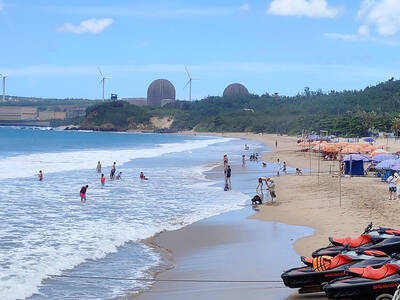
A dozen excited 10-year-olds are bouncing in their chairs. The small classroom’s walls are lined with racks of wetsuits and water equipment, and decorated with posters of turtles. But the students’ eyes are trained on their teacher, Tseng Ching-ming, describing the currents and sea conditions at nearby Banana Bay, where they’ll soon be going. “Today you have one mission: to take off your equipment and float in the water,” he says. Some of the kids grin, nervously. They don’t know it, but the students from Kenting-Eluan elementary school on Taiwan’s southernmost point, are rare among their peers and predecessors. Despite most of

A pig’s head sits atop a shelf, tufts of blonde hair sprouting from its taut scalp. Opposite, its chalky, wrinkled heart glows red in a bubbling vat of liquid, locks of thick dark hair and teeth scattered below. A giant screen shows the pig draped in a hospital gown. Is it dead? A surgeon inserts human teeth implants, then hair implants — beautifying the horrifyingly human-like animal. Chang Chen-shen (張辰申) calls Incarnation Project: Deviation Lovers “a satirical self-criticism, a critique on the fact that throughout our lives we’ve been instilled with ideas and things that don’t belong to us.” Chang

Feb. 10 to Feb. 16 More than three decades after penning the iconic High Green Mountains (高山青), a frail Teng Yu-ping (鄧禹平) finally visited the verdant peaks and blue streams of Alishan described in the lyrics. Often mistaken as an indigenous folk song, it was actually created in 1949 by Chinese filmmakers while shooting a scene for the movie Happenings in Alishan (阿里山風雲) in Taipei’s Beitou District (北投), recounts director Chang Ying (張英) in the 1999 book, Chang Ying’s Contributions to Taiwanese Cinema and Theater (打鑼三響包得行: 張英對台灣影劇的貢獻). The team was meant to return to China after filming, but